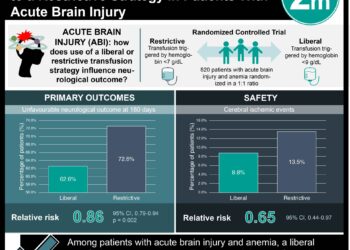Imaging differences between adult and pediatric TBI
Image: PD
1. Pediatric TBI more likely to have skull fracture, epidural hematoma, and lower Rotterdam CT scores.
2. Pediatric TBI less likely associated with contusion, SDH, SAH, and compression of the basal cisterns.
Evidence Rating Level: 3 (Average)
Study Rundown: TBI is a significant cause of morbidity and mortality in the pediatric population. However, acute TBI management protocols and research, including trials, are based largely on adult TBI with pediatric TBI patients typically excluded. The authors reviewed CT scans from a large cohort of consecutive non-penetrating TBI patients at a level one trauma center and found significant differences in imaging characteristics despite similar demographic and GCS presentations. These differences were thought to be the result of anatomical differences and differences in the biomechanics of the injury. Given the growing literature on the strength of imaging and clinical scales of TBI for predicting outcome over GCS, differences in adult and pediatric imaging in TBI can have a significant impact on management and outcomes. Main limitations to this study include the significant difference between mechanisms of injury in adult and pediatric populations. Also, the high proportion of the pediatric cohort that were transferred from an outside institution may have introduced some selection bias as well.
Click to read the study in JNS
Relevant Reading: Guidelines for the acute medical management of severe traumatic brain injury in infants, children, and adolescents
In-Depth [retrospective]: This study reviewed CT scans from a large cohort of over 1200 consecutive non-penetrating TBI patients at a level one trauma center over a 30 month period. Pediatric patients with non-accidentalhead trauma were excluded. Distributions of gender, race, and GCS were not significantly different between the two groups. Most common mechanisms of injury in the Pediatric patients were significantly more likely to have skull fractures and epidural hematomas (OR 3.21, 1.96; p < 0.01). They were less likely to have contusion, SDH, SAH, or basal cistern compression (p <0.05). Rotterdam CT scores were significantly lower in the pediatric population. Nearly half of the pediatric patients were transferred from an outside facility but there were no differences in this population for the metrics examined on subgroup analysis.
By Allen Ho
©2012-2013 2minutemedicine.com. All rights reserved. No works may be reproduced without expressed written consent from 2minutemedicine.com. Disclaimer: We present factual information directly from peer reviewed medical journals. No post should be construed as medical advice and is not intended as such by the authors, editors, staff or by 2minutemedicine.com. PLEASE SEE A HEALTHCARE PROVIDER IN YOUR AREA IF YOU SEEK MEDICAL ADVICE OF ANY SORT.






